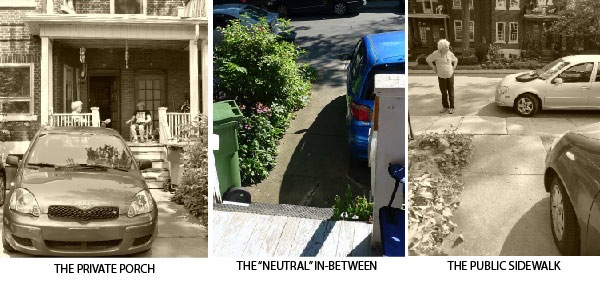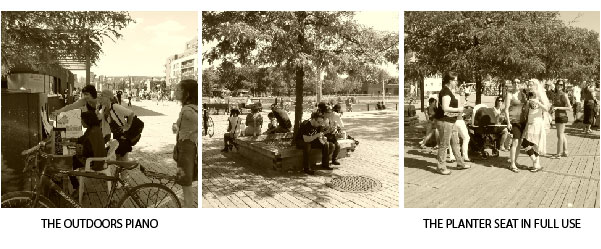INTRODUCTION
Since my first article where I presented and illustrated the spatial and social dynamic of getting along in urban society (i.e. moving along the city’s pathways or placing ourselves and our activities in the city’s various settings) I have received positive comments from both environmental design specialists as well as from environmentally-aware people. One person from the latter group recently shared with me a particular situation illustrating, fittingly, the principles of urban sociability put forth in this previous article.
I will present the case of B.K.’s front porch, access sidewalk and car parking space adjacent and fronting a public sidewalk and street. These areas constitute the ‘Here’ and ‘There’ where getting acquainted with neighbors takes place. More importantly, it is where the spatial and social morphing of neighboring houses and their occupants into THE/OUR neighborhood happens.
CASE STORY
First is B.K.’s report of the situation and its evolution, published with his permission. I will interject and follow with comments and illustrations of my own.
B.K.: I like this distinction of ‘Here’ and ‘There.’ Since your talk about balconies at UQAM, I have become very conscious of the “act” of sitting on the front porch, a mere 20 feet from the public sidewalk.
Making the choice of the “act,” I am consciously inviting an interaction that involves the ‘Here and ‘There.’ This afternoon, I was sitting on the front steps, listening, looking, observing. By sitting on the front steps, as opposed to sitting in the rocking chair on the porch, the steps put me on the edge/borderline of the ‘Here’ which leaves myself open to contact with the ‘There.’ Whereas sitting in the rocking chair anchors me more in the ‘Here’…
B.K. has intuitively sensed what Edward T. Hall in The Hidden Dimension calls the far distance of social involvement (about 15ft) at which one must pull back if not desirous of interaction. On the other hand, this is also the distance one gets closer to indicate the desire to interact. While on the porch B.K. is not only beyond the public distance (about 20 feet) where interaction is not yet called for, he is also located within the house-as-Here perimeter, so to speak, which he perceives as a definite ‘Here’ while the sidewalk is a definite ‘There.’ Sitting on the steps that lead from porch to sidewalk B. K. has moved outside the porch enclosure and become exposed, at just under 20 ft from the public sidewalk, to that situation of implied desire for social contact.
B.K.: So R. D. walks by and we start talking about Borough politics and before you knew it, I had climbed down the 4 steps onto our sidewalk and R. came up halfway up the sidewalk and we met in the “neutral zone” (If I can coin a space) between the ‘Here’ and ‘There’…Then C., a neighbor who recently moved back to his old house after a hiatus of 10 years, parked his car and R., who knows C., and I went to the ‘There’ to greet him and welcome him back to the ‘hood. Then my new next-door neighbor pulled up on his bicycle and we introduced new neighbor, M., to old neighbor, C…
The sight of a familiar face passing on the public sidewalk, at the distance where facial recognition is still possible, causes B.K. to move closer in order to be able to talk at a normal tone of voice, and in doing so, he realizes that he is “in between” two defined “places” which are ‘Here’ and ‘There’ to each other: the private porch and the public sidewalk. The social circumstances cause the two neighbors to move to the street where an old neighbor known to both is parking his car and, as a fourth newly installed neighbor arrives on his bike, the three old-time neighbors move toward him to complete mutual introduction.
B.K.: Now, it seemed, that the ‘There’ had become a ‘Here’…The neighborhood had morphed from individuals into a social group (identifiable to a ‘here’).
Since these social introductions occurred on the public sidewalk, considered a public ‘There’ as opposed to the perceived distance of the private ‘Here’ porch, the very fact of the new social link that unites the four neighbors turns the ‘There’ of the publicly shared sidewalk into the ‘Here’ of a group’s common/shared neighborhood.
It seems to be difficult for “physical” neighbors who don’t know each other to identify with the physical space (‘There’) that encompasses their houses and to refer to it as their (‘Here’) neighborhood, until they feel part of a street-based social group of sorts, with stakes in collective mutual help and security, etc.

The street based neighborhood:


B.K. then goes into further detail about what he referred to as “a dance”: the intertwined social and spatial dynamics of getting along in social situations.
B.K.: And the car? As you know it sits practically on our sidewalk, so it is in the “Neutral zone” but socially, it is ours. However, neighbors lean on it, roof is the right height, conversation is made, contacts are renewed or new ones made…and the space is narrow, so we are forced closer. I try to imagine it without the car and realize that it is a social prop; rather that feeling awkward, standing around with your hands in your pocket, you have something to hold on to, as if that piece of car roof is your space, and you are sharing the car with the others. Interesting dynamic, a crowd…
B.K. has hit upon the opposed polar notions of socio-petal space versus socio-fugal space i.e. those spaces possessing physical features which facilitate social interaction. Such features draw people to each other. Spaces lacking these physical features, or possessing others, thereby inhibit social interaction by pulling people away from one another.
From a practical point of view, consider for instance the design of open spaces. Those that remain empty of users for lack of these socio-petal features include: barren parking lots, spaces under overpasses, and sometimes very large featureless “parks.”
What B.K. has discovered and described so well above, is the role of his parked car in front of his house. Because its roof is “at the right height,” the car seems to provide an easy point for the resting of ones arms and for the leaning ones weight as an excuse, if you wish, for comfortably being and remaining in someone’s yard the duration of an interaction. In other words, a definite socio-petal feature fueling urban sociability!
Why do we need an excuse? Because deep inside we have internalized the social dictate that sidewalks are made for moving. Any stopping without a reason comes under loitering or at least suspect behavior!
B.K. then goes on to generalize the phenomenon by describing other socio-petal features he remembers experiencing in various places.
I think it is important that there be these public spaces, and that there be “things” in the park that make being there okay. It can be a bench, water fountain, Bocce, Pétanque; one of my grade schools had a bocce court. We would watch the retired Italian gentlemen, some playing, the rest standing around making comments about bocce, politics, the price of olive oil, the quality of the latest grappa from the old country…Trees – people lean on trees – make conversation easier, so you don’t feel so naked, so exposed…Exposed to what? Or as Bob Dylan put it “Gimme shelter from the storm.”
B.K., again, has intuited the sociability principle, which states: nothing attracts people to places like the presence of other people there. Jan Gehl, in his Life Between Buildings, notes how people will gather to watch others working or playing, or to sit near them and watch the workers and/or players, and their onlookers in order to interact with them.
I bring several examples of such features in full socio-petal action: an outdoors piano and raised tree planter seats located in an open public area near the Atwater Public market of Montreal and the Lachine Canal.
In all these cases we note the presence of trees shading the features, making them doubly attractive on a sunny summer day.

DISCUSSION
As the case story presented here indicates, the social and spatial dynamics of urban sociability is a complex affair of space and time, or, as the Dutch architect Aldo Van Eyck used to say: of place and occasion.
It is not everyday that one can have access to a story, i.e. to a narrative sequence of events, or occasions, whereby places take on their full sociability flavor. I am thankful to B.K. for his interest in the question of ‘Here’ and ‘There’ and for urban sociability to the extent of describing and analyzing a meaningful set of situations that embody the phenomena of getting along among neighbors, and where it is done.
I will keep searching for, and documenting, spaces that bear traces of their life as places encouraging urban sociability, and report on them.
A NOTE ON B.K.
B.K. are the initials of a good friend, retired philosophy teacher and colleague photographer who, inspired by the notions of urban sociability as developed in my first article, proceeded to report on a social experience he found to embody much of the concepts outlined in that article. He kindly requested his privacy be respected by not mentioning his full name but only his initials.
Maurice Amiel, M. Arch. (U.C. Berkeley) is retired professor of Environmental Design at the School of Design, University of Quebec at Montreal, where he was involved mainly in environment-behaviour teaching and applied research projects. In order to promote environmental awareness, he has turned after retiring to documenting and writing about various physical and human agents contributing to a sense of self, place and sociability ... I wish to add to my interests the fundamental role of light in photography and the visual structure of all 2D forms of artwork.
